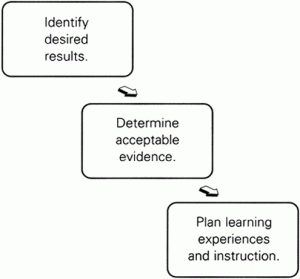
Most educators have come across the concept of backward design in the past few years. As the name indicates, it's a method of curricular design in which the instructor starts by establishing desired results for a particular chapter, unit, course, or sequence. Then he or she works backwards to identify evidence of learning and put into place various instructional practices (i.e. activities, tasks, assignments, projects, etc.) to achieve those desired results.

In our world language classes, like many other disciplines, exit outcomes of a particular unit or chapter are often assessed via traditional exams that assess a student's ability to use vocabulary and grammar appropriately and perform tasks like reading and writing in the target language (though teachers implementing project-based learning or task-based language teaching often employ alternative assessments). Assessing speaking authentically, however, can be difficult in a traditional classroom for a variety of reasons (large class sizes, technology limitations, lost classroom instruction time). Extempore, however, is a simple, convenient way to avoid the constraints of scheduling 1:1 interviews while still assessing your students' speaking abilities authentically as they reach the end of a particular unit.
However, as language instructors, it's also important to think about exit outcomes as students reach the end of a sequence of courses as a way to demonstrate global proficiency and teaching effectiveness. For instance, I taught for many years at a university that required students, before satisfying their language requirement, to take a modified Oral Proficiency Interview (OPI) to verify level-appropriate speaking proficiency. Though the end result was extremely beneficial, carrying out this interview required countless hours of face-to-face meetings between instructors and teachers and countless more hours of assessment. These sorts of demands are enough to make a language department, particularly one with limited resources, feel discouraged and at a loss at what to do.

Extempore, though, is the perfect way to easily assess exit outcomes. Firstly, it removes the need to set up a series of 1:1 interviews and instead allows students to complete the interview on their own time. Given the ubiquity of mobile devices and the way that modern students engage with them, online evaluation is often welcomed by students, especially when it reduces their speaking anxiety.
Secondly, Extempore is extremely versatile thus providing instructors with seemingly countless ways to assess student abilities. In terms of backward design, this process would be as follows.
- Determine what you want your students to do in the target language first. What task are they completing? What problem are they solving?
- Next, determine what language and grammar students need to know in order to use the language in this way.
- Finally, determine what will be acceptable evidence of students showcasing these skills.
As students grow comfortable with the target vocabulary and structures, they will be better prepared to accomplish the final task or problem that you initially conceived. And all of this practice can be done directly on Extempore. What's more, share you assessments with colleagues in your department to help solidify horizontal alignment among your classes and ensure consistency in your assessments.


